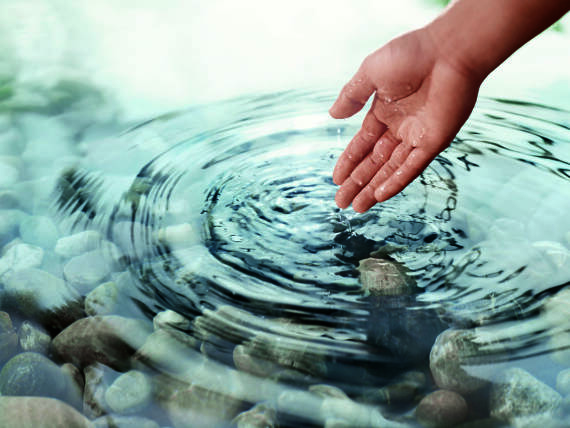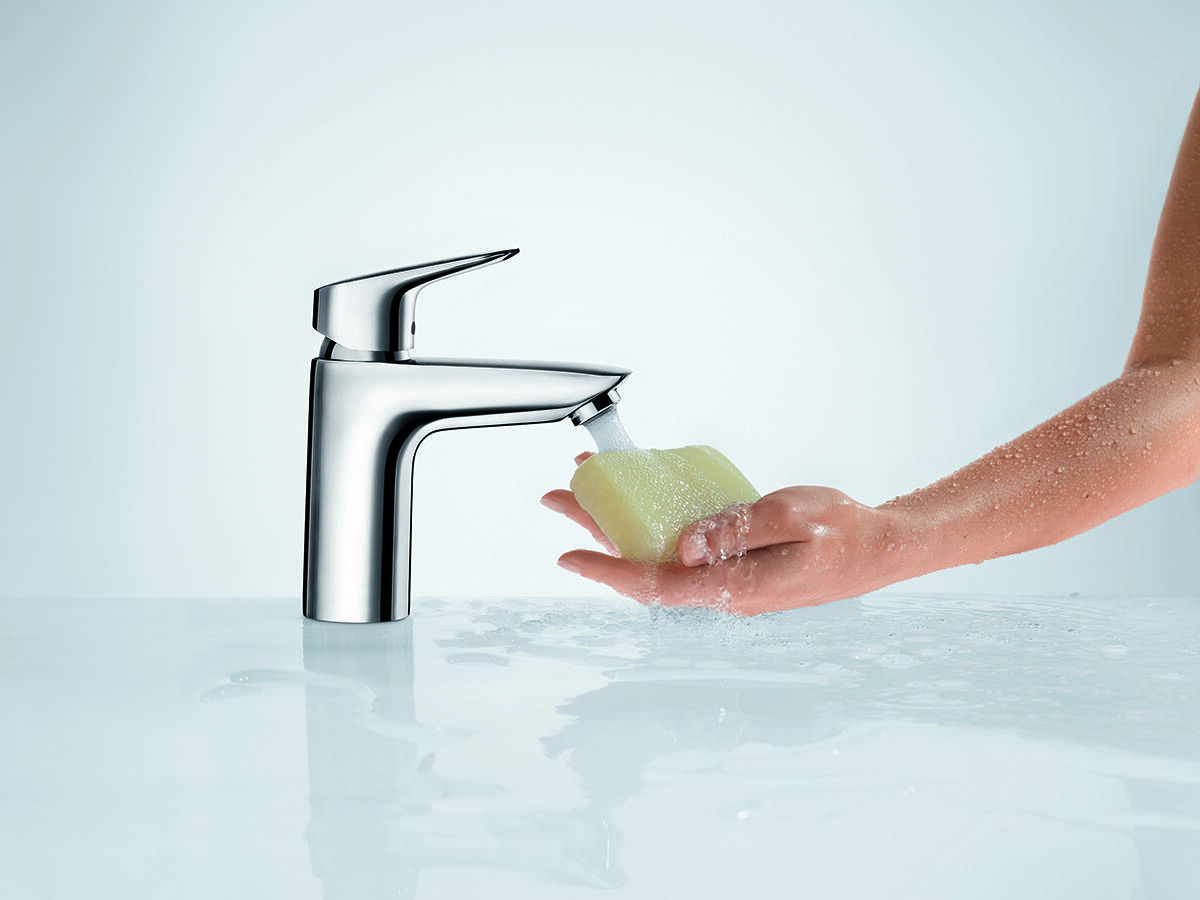Climate protection starts with the hands
hansgrohe water saving tips and resource-conserving products
Water is precious. Those who use it economically can contribute to environmental and climate protection – and also spare their wallet. Saving water is easy. Even small changes in our daily habits can help. Find out how you can automatically save water with modern technologies here. And what else you can do to avoid wasting this valuable resource.

Showering instead of bathing: This saves an enormous amount of water
A warm, pleasant bath is good for the soul. However, this pleasure consumes 100 to 200 liters of water, depending on the size of the tub. That’s quite a lot, especially since every single liter has to be heated. Showering is much more economical: It only consumes 40 to 60 liters on average. Perhaps you could save your full bath for special occasions and get yourself a wellness shower instead? If you want to go one step further, choose resource-conserving models for hand and overhead showers.
Water saving tip 1: Install modern shower products – EcoRight showers
With an EcoRight shower from hansgrohe, you can save up to 60% more water compared to a conventional shower head. The difference lies in the inner workings of the shower: The EcoRight technology automatically limits the water flow to approximately 6 to 9 liters per minute. Because less water has to be heated as a result, EcoRight also helps save energy. And: Those who use less fresh water also pay less drainage fees. The most resource-friendly shower at hansgrohe is the Crometta 85 Green hand shower. It consumes just under 6 liters of water per minute (at 3 bar). Incidentally: An EcoRight shower with several spray modes can properly pamper you despite a lower flow rate.
Water saving tip 2: Airing up and enriching water with air – AirPower showers
If you believe that less shower water also means less showering comfort, you can expect a sparkling surprise with hansgrohe AirPower. The technology is as simple as it is ingenious: Less water + more air = Full showering pleasure. The water is generously enriched with air in the shower, making the water droplets plumper, softer, and smoother. When taking a shower, you can feel the comfortably sparkling AirPower all over your skin. An AirPower shower hardly ‘sprays.’ Its shower jet makes more out of less water, and makes effective use of the bubbling power of air. All hansgrohe showers with this function therefore provide you with intensive, environmentally-friendly showering pleasure.
The scrimpers under the faucets reduce your water requirements

If you don't have solar panels on your roof or use geothermal energy, you will inevitably use fossil fuels to heat your water. Whoever succeeds in saving warm water in their everyday life reduces climate-damaging carbon dioxide and thus their ecological footprint on earth. Besides that, they're also slimming down their energy bill. Don’t want to waste warm water when washing your hands every day? Good. hansgrohe has invented an environmentally friendly technology for this as well.
Water saving tip 3: Saving hot water the smart way – with CoolStart faucets
A lavatory faucet with hansgrohe CoolStart technology reduces your energy requirements day in, day out, automatically. Because with these faucets, hot water only flows when you really need it. How does that work? If the single-hole faucet handle is in the middle position, only cold water will flow out. Hot water isn't sent through the pipelines until you deliberately turn the lever. CoolStart marks an environmentally friendly trend in the bathroom world while also making things easier for your wallet.
Water saving tip 4: Use intelligent faucets – EcoRight
All hansgrohe faucets are equipped with EcoRight technology as a standard feature. This means: They consume up to 60% less water than conventional faucets. A precision elastomer, which automatically reacts to different water pressures and changes its shape, constantly limits the water flow to around just 5 liters per minute. With hansgrohe faucets, you can save a lot of water (and drainage fees) without any action on your part. And: There are no energy costs for every liter that doesn't need to be heated.
Hansgrohe faucets help conserve resources
Modern operating technologies make saving raw materials child’s playWith a convenient single-hole faucet or a Select faucet, you can decide at any time when you want the water to flow and stop in the bathroom and kitchen. Sophisticated hansgrohe operating technologies help you to switch the water on and off quickly. The investment in a new, frequently used product such as a faucet will quickly pays for itself. And the environment will thank you for your contribution anyway! Water saving tip 5: Single-hole faucet instead of two-handle faucetWhile you wait for the water to get the right temperature and the right amount when turning the two handles, much of it is already flowing down into the rivers unused. Apart from the fact that modern single-hole faucets bring considerably more operating pleasure to your home, they can help set the desired water quantity and temperature much more quickly than two-handle faucets. With single-hole faucets, you gain time and comfort. And you’ll soon have more money left. Water saving tip 6: Shut off the water at the touch of a button – with SelectWith hansgrohe Select technology, the classic operating lever on the sink disappears completely. The water flow on these leverless faucets can be conveniently switched on and off at the touch of a button. This encourages you to save water every day – and lets you select your shower pleasure. Sink and sink unit faucets with the Select function are not only economical, they also have a minimalist design. They let your vanity and your sink shine in an ultra-modern way. |
Water guzzlers? Bid them goodbye. How to save water in your everyday life

In our bathrooms and kitchens, precious water often disappears unused down the drain – simply because nostalgic faucets or outdated shower systems are draining it away. Let’s identify the biggest water guzzlers and money wasters. To consciously reduce water consumption in everyday life.
Water saving tip 7: Repair or replace dripping faucets
Is your faucet running? It’s going to be more expensive than you might think in the long run. Have dripping faucets sealed as soon as possible. Sometimes even replacing a seal is actually enough. If, on the other hand, your faucet is already weak, it should finally be retired. Please replace the old iron with a modern faucet with a water saving function.
Water saving tip 8: Pay attention to energy efficiency and water consumption when buying new equipment
What applies to faucets also applies to shower heads, washing machines, and dishwashers: Ancient models usually consume significantly more water than new ones and belong in the recycling yard. Pay attention to the energy efficiency class when purchasing new equipment. Which appliances save a lot of water and energy? Be sure to choose environmentally friendly models from classes A to A+++. Speaking of efficiency: Washing machines and dishwashers should never run half empty. Do not switch on the machine until it has been optimally loaded. You can usually do without the pre-rinsing or pre-wash program. Many machines have an environmentally friendly short cycle for fewer dishes/less laundry.
Even more water saving tips...
- ... for the bathroom: Anyone who lets the water run while brushing their teeth or shaving is wasting – depending on the faucet – 5 to 15 liters of water per minute. Please turn it off in between! You can use a toothbrush tumbler when brushing your teeth. And pooling just a little water in the sink is enough for wet shaving. For the toilet, it’s worth installing a flush/stop button or a dual flush. For “number one,” a flush volume of 3 liters is sufficient. Your water bill will tell you what that represents in your locality.
- ... for the garden: Lawns usually do not require watering – even brown grass recovers after the next rainfall. Water should be used sparingly in the rest of the garden, and plants and flowers should only be watered at dusk. In this way, less water is wasted due to evaporation from the plants and pots.
- ... for our consumption habits: A lot of water and energy is lost during the production and disposal of disposable bottles. A better choice: Buy deposit and returnable glass, or PET bottles. They limit the use of materials and energy. Fruit and vegetables often travel a long way before they arrive at our supermarkets. A lot of water and energy is used in farming, processing, and transport. Regional, seasonal products are much more environmentally friendly. Didn’t you want to eat a healthier, more vitamin-rich diet anyway?
Authorized Dealers

